Themed collection Nanoscale quantum technologies

Introduction to nanoscale quantum technologies
Qing Dai, Chao-Yang Lu and Zhipei Sun introduce the Nanoscale themed collection on Nanoscale quantum technologies.

Nanoscale, 2023,15, 10858-10859
https://doi.org/10.1039/D3NR90099A
Silicon photonics interfaced with microelectronics for integrated photonic quantum technologies: a new era in advanced quantum computers and quantum communications?
Silicon photonics is rapidly evolving as an advanced chip framework for implementing quantum technologies.

Nanoscale, 2023,15, 4682-4693
https://doi.org/10.1039/D2NR05610K
From cavity optomechanics to cavity-less exciton optomechanics: a review
Cavity optomechanics investigates the interaction between electromagnetic waves and mechanical motion enhanced by the resonant cavity. In cavity-less exciton optomechanics, the resonant cavity is replaced by excitonic resonance.

Nanoscale, 2022,14, 16710-16730
https://doi.org/10.1039/D2NR03784J
Photon pairs bi-directionally emitted from a resonant metasurface
SPDC in a metasurface with the signal and idler photons emitted in opposite directions.

Nanoscale, 2023,15, 2567-2572
https://doi.org/10.1039/D2NR05499J
Terahertz cavity optomechanics using a topological nanophononic superlattice
A terahertz multi-optical mode cavity optomechanical device is designed using a topological superlattice and Ωm=ωj-ωj-1≠ωj+1-ωj. Scattering photons could doubly resonate with cavity modes at an anti-Stokes (Stokes) frequency and pump frequency.

Nanoscale, 2022,14, 13046-13052
https://doi.org/10.1039/D2NR03376C
Nitrogen vacancy defects in single-particle nanodiamonds sense paramagnetic transition metal spin noise from nanoparticles on a transmission electron microscopy grid
Non-integrated correlative light-electron microscopy with nitrogen vacancy sensing on transmission electron microscopy finder grids for the study of paramagnetic Prussian blue analogue nanoparticles.
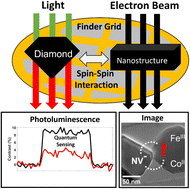
Nanoscale Adv., 2023,5, 6423-6434
https://doi.org/10.1039/D3NA00155E
Vertically oriented self-assembly of colloidal CdSe/CdZnS quantum wells controlled via hydrophilicity/lipophilicity balance: optical gain of quantum well stacks for amplified spontaneous emission and random lasing
Novel, vertically oriented self-assembly of core/shell CdSe/CdZnS colloidal quantum wells stacked in film via the control of hydrophilicity/lipophilicity is shown for optical gain media, allowing amplified spontaneous emission and random lasing.

Nanoscale, 2023,15, 9745-9751
https://doi.org/10.1039/D3NR00170A
Novel two-dimensional magnets with an in-plane auxetic effect
Magnetic ordering of 2D auxetic magnets is more stable than that of non-auxetic ones under mono-axial strain.
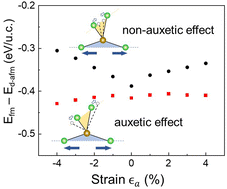
Nanoscale, 2023,15, 9365-9371
https://doi.org/10.1039/D3NR01458D
Spin transfer torques due to the bulk states of topological insulators
We determine the spin transfer torque due to TI bulk states, showing that it has a distinguishable signature and can be sizeable in real samples.

Nanoscale, 2023,15, 8437-8446
https://doi.org/10.1039/D2NR05176A
Spontaneous valley polarization and valley-nonequilibrium quantum anomalous Hall effect in Janus monolayer ScBrI
By obtaining the real magnetic anisotropy energy (MAE) under different strains, when 1.5% < ε < 1.8%, due to spontaneous valley polarization, intrinsic out-of-plane (OOP) magnetic anisotropy, and a chiral edge state, the VQAHE can reliably appear between two HVM states.

Nanoscale, 2023,15, 8395-8405
https://doi.org/10.1039/D2NR07221A
Quantum plasmonic two-dimensional WS2–MoS2 heterojunction
Quantum plasmonics enhance photoluminescence in two-dimensional heterostructures.
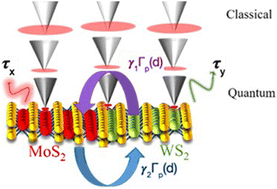
Nanoscale, 2023,15, 7318-7328
https://doi.org/10.1039/D3NR00861D
Strain-induced ordered Ge(Si) hut wires on patterned Si (001) substrates
In this study, we demonstrate uniform Ge hut wire arrays on a flattened surface by multi-layer growth of strained Ge(Si) layers separated with Si spacer layers on top of site-controlled GeSi hut wires.

Nanoscale, 2023,15, 7311-7317
https://doi.org/10.1039/D2NR05238E
Coherent imaging and dynamics of excitons in MoSe2 monolayers epitaxially grown on hexagonal boron nitride
By performing ultrafast nonlinear spectroscopy, we assess the optical coherence of MoSe2 monolayers grown by molecular beam epitaxy.
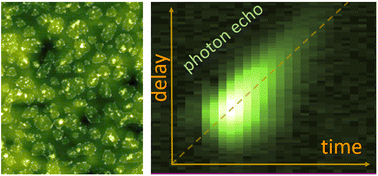
Nanoscale, 2023,15, 6941-6946
https://doi.org/10.1039/D2NR04844B
Performance of the nanopost single-photon source: beyond the single-mode model
The nanopost single-photon source exhibits surprisingly high collection efficiency, despite its geometrical simplicity, due to beneficial scattering into radiation modes.
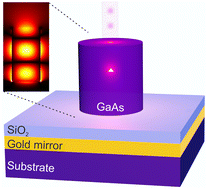
Nanoscale, 2023,15, 6156-6169
https://doi.org/10.1039/D2NR07132K
Two-qubit atomic gates: spatio-temporal control of Rydberg interaction
With pulse sequences of structured light, we achieve robust ultrafast high-fidelity C-PHASE gates in non-independent atomic qubits. The optimal protocols form lattices in parameter space rotated by an angle that depends on the proximity of the qubits.

Nanoscale, 2023,15, 4325-4333
https://doi.org/10.1039/D2NR04964C
Enhancement of spontaneous emission from CdSe/ZnS quantum dots through silicon nitride photonic crystal cavity based on miniaturized bound states in the continuum
A practical construction method for on-chip surface-emitting light sources on silicon-based integrated photonic devices, demonstrated with a SiN photonic crystal cavity on CdSe/ZnS quantum dots.
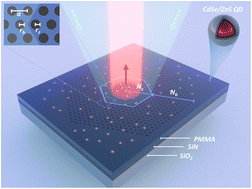
Nanoscale, 2023,15, 3757-3763
https://doi.org/10.1039/D2NR05031E
Non-centrosymmetric Weyl semimetal state and strain effect in the twisted-brick phase transition metal monochalcogenides
The nodal loop phase transition to Weyl fermion in twisted-brick-MoTe is realized via spin–orbit interactions. Strain effects can tune the topological strength strikingly; hence, a strain-tuned partly-ideal Weyl semimetal phase in MoTe was observed.

Nanoscale, 2023,15, 2882-2890
https://doi.org/10.1039/D2NR04946E
Insulator-to-metal phase transition in a few-layered MoSe2 field effect transistor
We report an insulator-to-metal phase transition in a few-layer MoSe2 field-effect transistor. The conductivity (shown in figure) becomes metallic at a critical carrier density of 1.2 x 1012 cm-2 and is analyzed using percolation theory.

Nanoscale, 2023,15, 2667-2673
https://doi.org/10.1039/D2NR05019F
Ferroelectric valley valves with graphene/MoTe2 van der Waals heterostructures
The control of the ferroelectric domains in this valley valve allows generating and tuning topological excitations, thus providing a promissing platform to print circuits displaying a ballistic behavior.
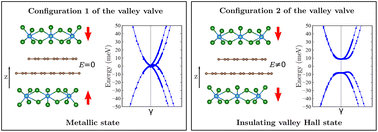
Nanoscale, 2023,15, 2181-2187
https://doi.org/10.1039/D2NR05185K
Purifying single photon emission from giant shell CdSe/CdS quantum dots at room temperature
Single photon purity of an individual quantum dot is severely compromised by biexciton emission. Giant shell quantum dots are allowing for biexciton spectral separation with a long-pass filter improving single photon purity at room temperature.

Nanoscale, 2023,15, 1645-1651
https://doi.org/10.1039/D2NR04744F
Interplay of Purcell effect and extraction efficiency in CsPbBr3 quantum dots coupled to Mie resonators
Perovskites quantum dots coupled to Mie resonators display an 18-fold luminescence enhancement. Spatially- and time-resolved measurements, coupled to numerical simulations, confirm increased absorption, Purcell factor and extraction efficiency.

Nanoscale, 2023,15, 1652-1660
https://doi.org/10.1039/D2NR05945B
The dependence of timing jitter of superconducting nanowire single-photon detectors on the multi-layer sample design and slew rate
The authors present the dependence of the timing jitter of superconducting nanowire single-photon detectors on the multi-layer sample design and slew rate.

Nanoscale, 2023,15, 1086-1091
https://doi.org/10.1039/D2NR04494C
AC-driven multicolor electroluminescence from a hybrid WSe2 monolayer/AlGaInP quantum well light-emitting device
A multicolor AC-driven light-emitting device by integrating a WSe2 monolayer and AlGaInP–GaInP multiple quantum well (MQW) structures.
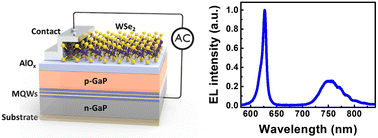
Nanoscale, 2023,15, 1347-1356
https://doi.org/10.1039/D2NR03725D
Uniaxial strain tuning of organic molecule single photon sources
We investigate repeatable and reliable tuning of single organic molecule fluorescence by applying strain via a piezoelectric substrate.
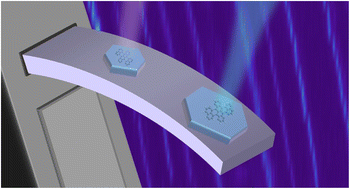
Nanoscale, 2023,15, 177-184
https://doi.org/10.1039/D2NR02439J
Deciphering the photophysical properties of near-infrared quantum emitters in AlGaN films by transition dynamics
We investigate the key photophysical properties of NIR quantum emitters from point defects in AlGaN films both theoretically and experimentally.

Nanoscale, 2022,14, 18115-18122
https://doi.org/10.1039/D2NR04978C
Impact of indirect transitions on valley polarization in WS2 and WSe2
Valley polarization is a new resource for optoelectronics and information technologies. This article demonstrates the critical role of indirect transitions in protecting valley polarization in few-layer WS2 and WSe2.
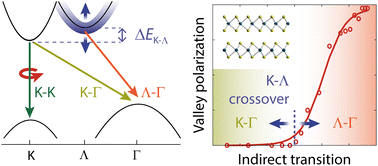
Nanoscale, 2022,14, 17761-17769
https://doi.org/10.1039/D2NR04800K
Hybrid electroluminescent devices composed of (In,Ga)N micro-LEDs and monolayers of transition metal dichalcogenides
With recent advances in GaN LED technology, we explore a new class of compact, stand-alone transition metal dichalcogenide electroluminescence devices.
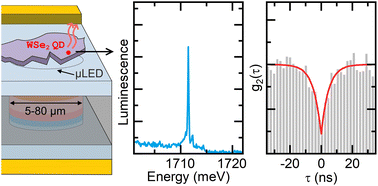
Nanoscale, 2022,14, 17271-17276
https://doi.org/10.1039/D2NR03970B
Highly-efficient radiative thermal rectifiers based on near-field gap variations
A schematic diagram of the proposed design scheme for highly-efficient radiative thermal rectifiers based on thermally-induced near-field gap variations.
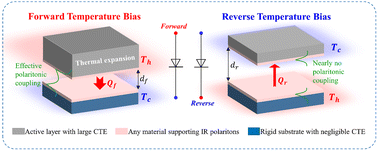
Nanoscale, 2022,14, 16978-16985
https://doi.org/10.1039/D2NR04350E
Nano-optical imaging of exciton–plasmon polaritons in WSe2/Au heterostructures
We maped in real space the propagative exciton–plasmon polaritons in WSe2/Au heterostructures. These polaritons are formed due to the strong coupling between excitons in WSe2 and surface plasmon polaritons on Au.
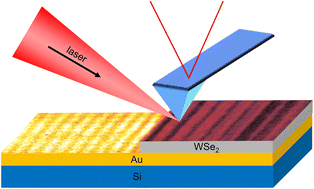
Nanoscale, 2022,14, 15663-15668
https://doi.org/10.1039/D2NR04321A
Synthesis of mono- and few-layered n-type WSe2 from solid state inorganic precursors
Tuning the charge transport properties of two-dimensional transition metal dichalcogenides (TMDs) is pivotal to their future device integration in post-silicon technologies.

Nanoscale, 2022,14, 15651-15662
https://doi.org/10.1039/D2NR03233C
Coupling spin defects in hexagonal boron nitride to titanium dioxide ring resonators
Spin defects in hexagonal boron nitride are coupled to microring cavity resonator.

Nanoscale, 2022,14, 14950-14955
https://doi.org/10.1039/D2NR02522A
Single charge control of localized excitons in heterostructures with ferroelectric thin films and two-dimensional transition metal dichalcogenides
Single charge control of localized excitons has been demonstrated in heterostructures with ferroelectric thin films and two-dimensional transition metal dichalcogenides, which are confirmed with magneto-photoluminescence spectroscopy.
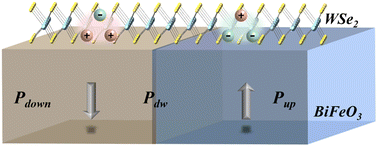
Nanoscale, 2022,14, 14537-14543
https://doi.org/10.1039/D2NR04119G
Machine learning enhanced in situ electron beam lithography of photonic nanostructures
Machine learning is used to improve in situ electron beam lithography capabilities. Specially trained algorithms increase the sensitivity by more than a factor of 10 in the deterministic processing of high-performance quantum light sources.

Nanoscale, 2022,14, 14529-14536
https://doi.org/10.1039/D2NR03696G
About this collection
Guest Edited by Professor Qing Dai (National Center for Nanoscience and Technology, China), Professor Chao-Yang Lu (University of Science and Technology of China, China) and Professor Zhipei Sun (Aalto University, Finland).
Materials and structures at the nanoscale play a key role in various current and emerging quantum technologies, such as quantum computing, quantum sensing and imaging, and quantum communication. In the last few decades, we have witnessed significant progress in nanoscience and nanotechnology, which has enabled great successes from fundamental research to applications in quantum technologies, facilitating completely new horizons in this area. This collection of research and review articles aims to provide a snapshot of recent progress in quantum technologies, including quantum materials, computing, sensing, imaging, photonics, optics and more, which we hope will inspire future developments.